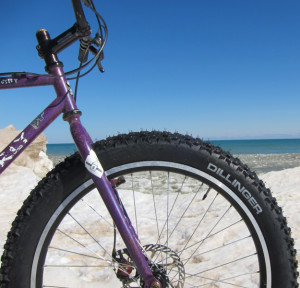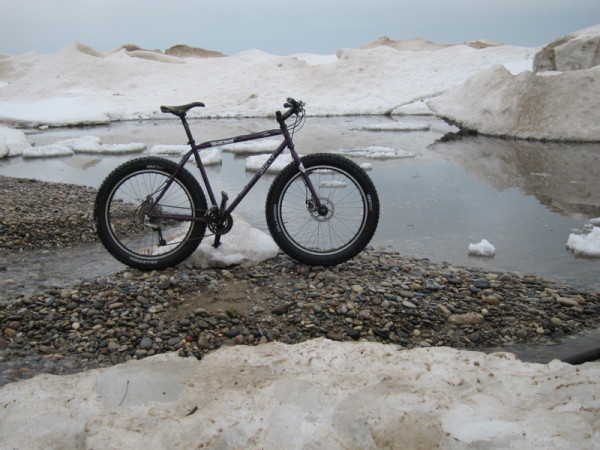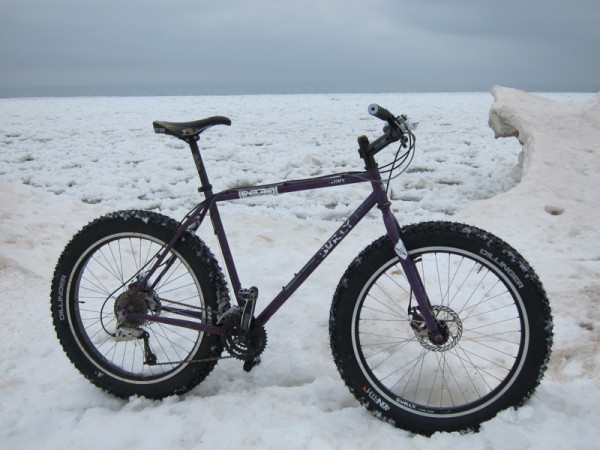By: Chris Zito
 The puppeteers at Black Ribbon HQ, delivered a set of 45NRTH Dillingers to me just in time for one of the bigger dumps of the snowy season. In the past I have mostly ridden Endomorphs, well, since the time when they were THE option and gum-walled. Up until recently when I changed up to a Nate rear and Larry front, I had been quite content with the Endos. However, once I switched to this newfound combo, I discovered a considerable difference under certain conditions, mostly off-camber sandy, wet, or icy surfaces, but also in some of the softer deeper dry sand. I mention this only to use as a reference of comparison, and will refer to this as set X. Now back to the Dillingers.
The puppeteers at Black Ribbon HQ, delivered a set of 45NRTH Dillingers to me just in time for one of the bigger dumps of the snowy season. In the past I have mostly ridden Endomorphs, well, since the time when they were THE option and gum-walled. Up until recently when I changed up to a Nate rear and Larry front, I had been quite content with the Endos. However, once I switched to this newfound combo, I discovered a considerable difference under certain conditions, mostly off-camber sandy, wet, or icy surfaces, but also in some of the softer deeper dry sand. I mention this only to use as a reference of comparison, and will refer to this as set X. Now back to the Dillingers.
So as I am mounting the Dillingers onto my Pug wheels, the shop crew at Rainbow Jersey is discussing what the manufacturers intended application for these tire is. Was it for fat-bike commuters? Winter MTB trail riders where the paths are trodden and icy, or simply enough, for ice racing? I decided to run the gambit and see for myself. BTW, I love how the bastards at Black Ribbon give me a product that you test to it’s limits, and that the result of finding or going past those limits means going DOWN! Thanks. And I’ll pass on the “breakaway” seat post test next week.
Naturally, as soon as the snow was flying and an inch or two had accumulated, it was time for the first test ride. The Commuter Test. (Another quick side bar here; the recommended pressure on the side wall of the Dillinger calls for 5-15psi, I rode them at approx. 7-9psi, in an attempt for the largest possible footprint but without getting too boggy.) My commute this day was about 6 miles. The temperature was 26(F) and snowing about an inch an hour. I was not impressed. They handled great in the fresh 2-3 inches of the bike path, but cookie dough type road conditions on the streets kept my front tire filling up, floating and surfing very much like set X would. My ideal choice for these conditions would be a track bike with 23-25c skinnys, but this is a Fat-Bike test so we will skip the “thin to win” commentary and say that the Dillinger is not the ideal tire for cinnamon oatmeal cookie dough conditions, there is nothing for them to bite into.
The next test took place the very next day, temperature 30(F), skies blue and sunny. Fellow test pilot Colin Fjord, and I met up at Klode Test labs for some romping on the beach. We were somewhat disappointed with the conditions, the snow being 4- inches (due to drifting) and “packy” (for lack of a better term) due to the temperature and sunshine. A stretch of beach that would normally take 5-7 minutes to ride, took us about 20-25 struggling minutes to cover.
Day three of testing took me back to Klode Test labs. Temerature 34(F), skies overcast. I decided to find some off camber packed down circumstances so naturally I started on the sledding hill. The ice was a packed slush kind of ice, not too hard, but by all means slick as!
On a straight decent down hill the Dillingers held well under soft front and rear braking until momentum took over and there was simply no stopping. Another line from the top right to the bottom left of the hill the studs did their job, minimal lateral slippage and good braking control. Once I hit the beach I found the conditions even more impassable than the previous test day, so I decided for another photo shoot and some placidity.
After a bit of meditation I took it up the hill and over to the local skating rink for some ice racing!! Once again that Ol’ bitch Ma Nature had other plans. The rink was more like a pond, with 2-6 inches of standing water on top of 3-4 inches of ice. Perfect! I was able to ride though the icy bottomed slurry with no problem with getting a bite and no slippage when “goosing” it a little. I am confident that set X would not have performed as well as the Dillinger in these conditions.
Day four of testing was few days later. The temperature was 22(F), the skies sunny, and we were headed back to the rink for some solid ice testing. By this time the rink had refrozen and was a bumpy craggy slick surface.
The Dillingers took me expediently across the test grounds in straight lines, but when taking turns just a bit sharper than I would consider possible on set X, I went down! After three good contusing trials I gave up and headed back to the sledding hill for some more masochism. There was less packed ice on the hill, but it was harder and slipperier than the previous test day.
Once again the straight line down gripped a bit initially but once momentum came up, stopping was not an option. The hardness of the ice also changed the side to side decent with the tires not hooking up enough to keep me from continuing to collect welts and bruises, and convincing me that I would definitely have a similar result on set X. Onward to the beach where conditions were still impassable, but parts of the foreshore had accumulated some nice ice boulder formations.
I made a few passes over the small ice/rock garden and found the Dillingers able to keep going, but, with a bunch of lateral sliding. However, not as much movement as I would expect from set X.
In the end, when I think about what my overall opinions of the Dillinger, I’m left a bit torn. They would be good for ice racing, if you’re willing to discover the point where your grip goes bye bye. If you’re a commuter that has more than a couple of miles of hard icy conditions, and a healthy bank account, get a set. You’ll enjoy them. The bottom line is that these skins are a big-ticket item and perhaps a bit of overkill, other than in specific extreme conditions and circumstances……but in those special conditions, they might just save your bacon.







Have you guys tried the tire chains that are available? Curious to see how they perform on fat bike tires.
Wow I’m, shall we say, less than impressed with this review. There’s no real comparison of other tires in like conditions. I’ve ridden Larry/Endo combo and hated it in the snow and changing conditions. The Huskers were great on packed trail but were dicey on ice and spun easy in deeper snow even at 5 psi. The Dillingers are by far the best all around tire for the variable conditions in winter. A bit noisy on the road but have excellent traction in snow and the absolute best on ice. The plate in my shoulder was expensive so I consider these tires cheap insurance.
Maybe you’ll like this review better – http://fat-bike.com/2013/03/45nrth-dillinger-%E2%99%A6-first-impressions/ – I wrote the first review and have no problem with any of the opinions in Chris’s Review. We call them as we see them.
Gomez, much closer to my experience with the Dillingers.
Bought a set of light HuDu’s (which I love) this fall and used them to slide into rotator cuf surgery on an way too fast ice under 6″ snow downhill. The op cast $2500, wish I’d kicked in the extra bucks for the Dillingers – they would have been cheap at twice the price!
I crashed hard while testing this set of Dillingers and separated my shoulder – in 5″ of soft snow – true story
I would be really interested to hear how the Dillengers compare to other studded tires like the Nokian Extreme, Nokian Freddy’s Revenz or Schwalbe Ice Spiker. Looking for something to ride around on lake ice.
I’m debating whether to buy a set of Dillengers or build a new wheelset around the Freddy’s Revenz I already have. New wheelset might be cheaper(!), but fat+studs would be more versatile, assuming they handle pure ice (nearly) as well.
I have a set of Escalators, fully studded (pretty much the same as the Dillingers – only less weight and more expense !). They compare to the Nokian 294 Gazza extremes (which I have on a 29er) in terms of Ice grip.
Many other peeps in the Twin Cities have some custom studded (ie, screws in larry’s etc). The large screws do a better job on sheet ice – but are a bear on the road/pathways.
I found a middle ground where it is possible to take out the factory carbide studs and swap out for a few (longer) steel screws.
If you want to go racing on sheet ice, then the custom screw route is the best (unrideable on any other conditions however). The Dillingers and Escalators are a good all-round winter tire that provides that little extra security when riding on snow/icy trails.
Greetings. I live in Minneapolis, and commute by bicycle year round due to the fact that I don’t own an automobile. My commute is, on average, 36 miles per day. I can honestly say that my Dillinger studded front tire has more than paid for itself with the hard-pack ice stretches. Last year, we had similar conditions to start out the winter: slushy, icy rain, turning to sleet, turning to snow, and then a massive temperature drop into the single digits all within 6-7 hours. Temperatures have only three times risen above freezing since November.
The stretches of white ice dusted with snow left both hips and elbows bruised and weary the first two weeks of 2012-2013 winter with at least 9 or 10 wipeouts in the first two weeks of commuting (three times in front of moving automobiles-when my front wheel would drift right out from under me with no urging, while riding a straight line.). I had my Pugsley outfitted with front and rear Husker Du’s. I decided this year to swap the front out with a studded Dillinger.
This (2013-2014) winter, the slush-into-freeze intro was worse than last year, and I have only had three wipe outs, all of them coming from rounding a corner and my rear Husker Du coasting right out from under me. The Dillinger holds steady on straights and corners, and although it isn’t the best tire for every type of winter riding, for commuting in extreme winter conditions, it’s a sure bet.
I ride Dillinger 5 studded during Park City winter and Husker du 4’s spring-fall and love both.